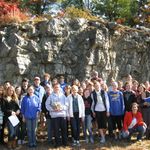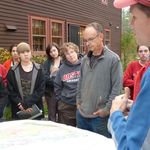By Jeremy Schwab
Five hundred million years ago, what is now present-day New England lay near the equator and was relatively flat. Then suddenly—geologically speaking—a change in plate motions sent the neighboring oceanic plate sliding into and beneath the North American plate, or craton. This was the first in a series of tectonic collisions that formed the Appalachian Mountains.
Seven years ago, BU Professor Ethan Baxter led a group of Boston-area high school students and BU undergraduates on a pilgrimage of sorts. Their mission? To collect rock samples in various sites in New Hampshire, Massachusetts, and Vermont that would help them tell the story of these ancient collisions. The new, National Science Foundation-funded program was called RoBOT, or Rocks Beneath Our Toes.
The RoBOT program has been very successful. Over seven years, Baxter, now chair of the Department of Earth & Environment, has brought well over 100 area high schoolers and more than 80 BU undergrads through the program. RoBOT and the Minerology course associated with it give participants valuable basic and intermediate geological skills, such as how to identify rock and mineral samples with the naked eye and through a microscope. Baxter also teaches his students about the role of minerals throughout Earth’s systems, and in particular their roles as natural resources and recording devices for Earth’s geologic history.

This past fall’s RoBOT program featured high school students from Acton-Boxborough Regional High School. During a Saturday rock-collecting excursion in October, the high schoolers and BU students spent part of the day in the Acton-Boxborough area sampling rocks. Then, the BU students continued on, collecting samples at sites in New Hampshire. The eighth and final site they visited was the New Hampshire home of Gina Sapiro, dean of Arts & Sciences, and her husband Graham Wilson, chair of Political Science.
The thirteen ES222 students—whose majors range from earth science, to geophysics and planetary science, to chemistry—descended on the Sapiro-Wilson home with rock hammers and sample bags in tow. “Years ago, Gina mentioned that we should come by,” recalls Baxter. “This year, we decided to do it.” The students collected rock samples on the professors’ property, then discussed what they had found as Sapiro and Wilson listened intently, no doubt intrigued to discover the history of the rocks on their own property.

Each fall, RoBOT follows a familiar routine. After a Saturday spent collecting field samples with the high school students, the BU students take the samples back to the lab at CAS, where the rocks are sliced and then shipped away to be sliced even further into translucent strips. The undergrads then put these razor-thin rock sections under a petrographic microscope, using complex physics to analyze the complex light patterns reflected from the minerals contained in the samples.
Meanwhile, the high schoolers do background research on the geology of the region, and then reunite with the ES222 students to do poster presentations at the end of the fall semester. In these presentations, each student tells the story of the rock he or she has been assigned to learn about. The rocks found in New England fall basically into two groups: igneous rocks such as granite that were part of ancient magma chambers at the base of mountains (New England was once home to active volcanoes); and metamorphic rocks such as schist that were formed in the intense pressure caused by the continental collisions that formed the Appalachians.